Krakow 3-Day Travel Guide – What to see, restaurants, transportation and itinerary

Have a look at our Krakow 3-day travel guide and discover the best the city has to offer, including hotels, restaurants, tips to avoid tourist scams and even a detailed list with everything you must see and do in Krakow in 3 days, including a day trip to Auschwitz-Birkenau.
Considered the historical capital of the Polish nation, a title it held for over 500 years, Krakow was one of the few major cities in the country to escape the massive destruction of World War II. As such, unlike Warsaw, Krakow boasts a classical charm, complete with its well-preserved old architecture and an imposing castle.
However, despite its picturesque appearance, Krakow bears the undeniable legacy of the most significant and horrific conflict in human history, since you can explore the famous factory of Oskar Schindler (yes, the one from the movie) and wander through the former Jewish ghetto in Podgorze. Additionally, the haunting Auschwitz Concentration Camp is located just 70 km from the city center, making it one of the most popular day trips from Krakow.
That being said, we invite you to have a look at our Krakow 3-day travel guide and discover the best the city has to offer, including hotels, restaurants, tips to avoid tourist scams and even a detailed list with everything you must see and do in Krakow in 3 days.
Krakow 3-Day Travel Guide

How to get to Krakow – Flights from Ireland
Considering this is the second most important city in Poland, it comes as no surprise that Krakow hosts one of the country’s busiest air hubs: John Paul II International Airport.
As such, if you’re traveling from Ireland, it is possible to fly directly to Krakow from Dublin and Shannon with Ryanair.
Krakow 3-day travel guide – Best time to visit the city
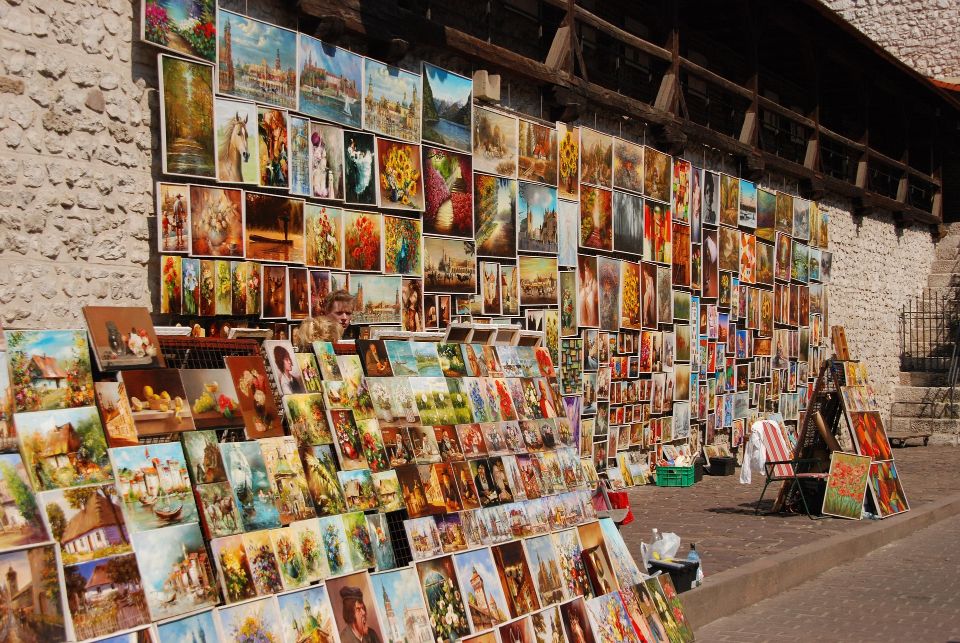
Considering the city is located in Europe, Spring, Summer and Fall are definitely the most sought-after months when it comes to booking a trip to Krakow. As a rule of thumb in central Europe though, shoulder-season is often the most pleasant time to visit, as temperatures will still be mild and accommodation prices will not yet be through the roof! As such, we recommend considering the timeframe between April and June, and between September and November.
However, and for those strong-willed enough to face the harsh Polish winter, visiting Krakow in the winter is also a great idea, as you’ll have the chance to experience the city’s extraordinary Christmas Market!
Documents needed for your trip to Krakow

Since Poland is part of the EU, Irish citizens only need to show a valid ID Card in order to be granted access to the country.
Krakow 3-day travel guide – Withdrawals, banking fees and travel budget
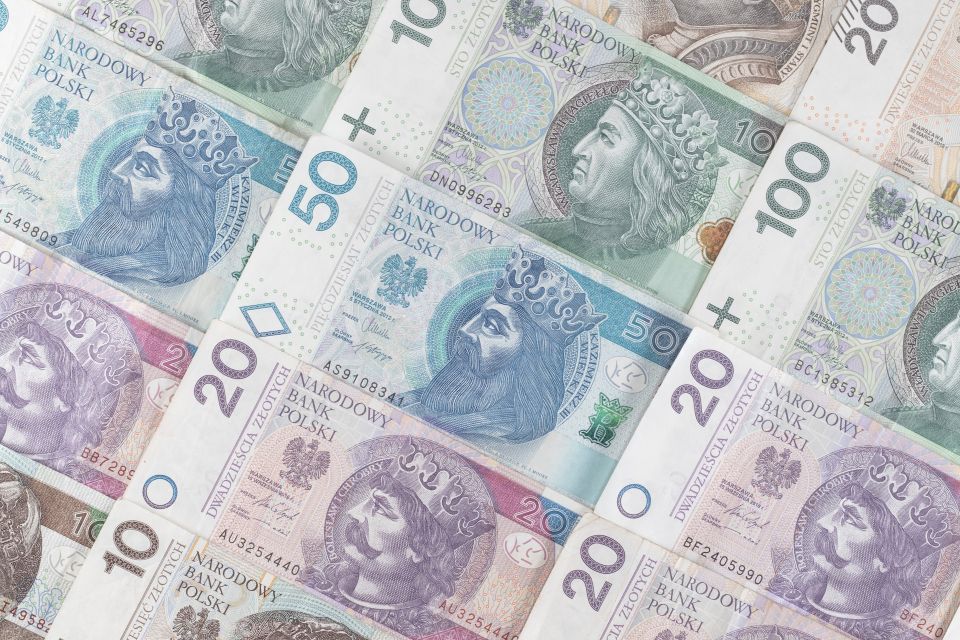
With the Polish Zloty (PLN) as Poland’s official currency, any withdrawal using an Irish bank card might incur in the payment of several different fees. Besides the percentual fee referring to the currency conversion, some Irish banks may also charge a flat commission for withdrawals made outside Ireland. In some instances, you may well end up paying 5%-6% of your original withdrawal in banking fees.
On the other hand, exchanging money before your trip is not a viable solution either. Besides not being any cheaper, it’s also not safe or wise to carry so much money on you during your trip. As such, we recommend using the services of online banking fintech companies such as Revolut, N26 or Monzo.
Although each have their own limitations and fees, they allow you to withdraw a certain amount in foreign currency without any fees involved. And even after that threshold is reached, costs are much smaller when compared to traditional banks. Sign up for Revolut for free >> to get 3 months of Premium.
It’s worth noting that in Krakow, as in most European countries, electronic payments are extremely common, and the need to withdraw cash is becoming increasingly rare. Nevertheless, if you do need to do so, we recommend using the following banks, which, at the time of writing, do not charge any withdrawal fees:
- Bank Pekao SA
- Santander
On the other hand, if you prefer to carry some cash and exchange it at your destination, here are 5 currency exchange offices in Krakow with very favorable reviews:
- Grodzka Exchange – Old Town
- Cool Kantor – next to the Barbican
- Zero Kantor – near Wawel Castle
- Grosz – Old Town
- Kantor Baksy – near Miejski Stadium
Krakow 3-day travel guide – Common scams and frauds
First and foremost, let me clarify that Krakow is an incredibly safe destination. With low crime rates and virtually no record of any terrorist attacks, this is the kind of place where you can feel comfortable both during the day and night.
However, and much like you would do in any other big city, using your common-sense is key. That means no taxis whose drivers refuse to start the meter, no accepting help from strangers when you’re using an ATM or trying to buy metro tickets and always keeping an eye out for your stuff when you’re walking through busy areas. We also recommend using an anti-theft bag. Unlike regular bags, anti-theft bags are specifically designed to prevent pickpockets and thieves from easily accessing your belongings. PacSafe is one of the leading brands in this category, producing bags that boast lockable zippers, cut-resistant materials and RFID-blocking fabric that helps protect against those trying to steal your credit card information through contactless technology. We currently use the Lunar, Crossbody and Sling models and can personally attest to their high-quality materials – especially the locking zipper technology, which makes it nearly impossible for anyone to open your bag without you noticing. Also, since the local currency is different, do not exchange money on the streets. In fact, even at currency exchange offices, it’s a good idea to double-check the amount before completing the transaction, as some places in the city are famous for having hidden fees.
Last, but certainly not least, a word of caution to the LGBTQ+ community. When looking at all these countries in Europe, Krakow is far from being the most welcoming destination when it comes to sexual minorities. The Polish government, overwhelmingly popular judging by recent election results, is well-known for its populist speech on the fight against what they perceive as “gender ideology”, trying to associate homosexuality to truly perverse concepts, such as pedophilia, sexual harassment and indoctrination. As such, we advise you to be more cautious than you would be at home when it comes to PDA’s towards same-sex people.
Where to sleep in Krakow – Hotels and Accommodation

If you’re looking out for a place to stay on our Krakow 3-day travel guide then we got your covered!
Similar to most countries/cities that were once on the other side of the Iron Curtain, Krakow also tends to have a relatively lower cost of living than what we are accustomed to. It is true that the city is not as inexpensive as it used to be, but it remains an affordable destination.
That being said, here are a few hotel options which have passed our value-for-money test:
- Hostel – Greg&Tom Party Hostel
- € – Hotel Ibis Krakow Centrum
- €€ – AC Hotel by Marriott Krakow
- €€€ – Grand Ascot Hotel
Krakow 3-Day Travel Guide – Transportation between the airport and the city centre

Upon landing in Krakow, the best way to reach the city is by using the train. The station is located inside the airport, so passengers just need to follow the signs. These vehicles run between 04h25 and 00h20, leaving every 30 minutes towards Krakow Central Station (Krków Glówny). The trip takes about 18 minutes and tickets cost 17 PLN. You can buy them from the automatic machines located inside the arrivals’ terminal (white, with an inscription saying “Malopolska Karta Aglomeracyjna”) or directly from the ticket inspector inside the train (only cash).
On the other hand, if you happen to land outside of the train’s operating times, you may rely on bus 902, the night service with scheduled departures at 23h25, 00h20, 01h20, 02h20, 03h20, 03h55 and 04h55. Once again, you can get your ticket from the machines inside the arrivals’ terminal or at the bus stop, though the devices are different. For bus tickets, you must use the black machine saying “Krakowska Karta Miejska” and select the option “Zones I+II suburban services”. Tickets cost only 6 PLN and must be validated inside the bus. As for the bus stop, is located right outside the terminal, so you just need to follow the signed path. Keep in mind the terminus will be the Central Bus Station, so, if your place of accommodation is located in the Old Town, you’ll be better off by having the driver drop you off at the Juliusz Slowacki Theater.
Krakow 3-Day Travel Guide – Public transportation
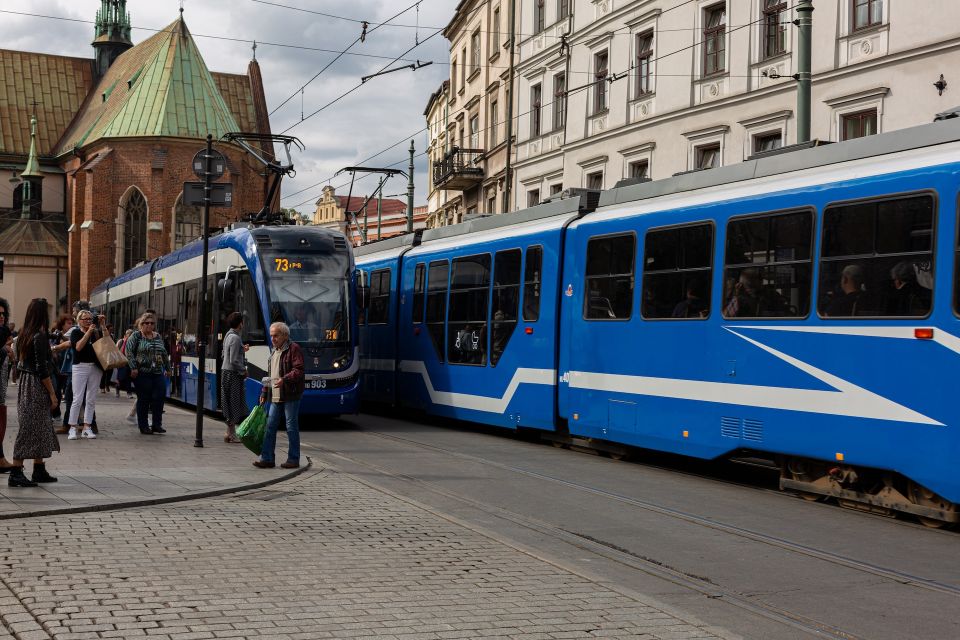
Honestly, except for the trip between the airport and the city center (explained above) and for visiting the Wieliczka Salt Mines, you’ll hardly have to use the public transportation system in Krakow. The city is extremely compact, and while there’s a lot to see and do, it’s perfectly possible to complete most journeys on foot, even between different districts (Old Town, Kazimierz and Podgorze, for example).
That being said, and if you really need to rely on public transportation within the city, you’ll most likely end up using only the tram, an above-surface metropolitan that links the city center to the different suburbs where most locals live.
Krakow Tram – Maps, Tickets and Fares
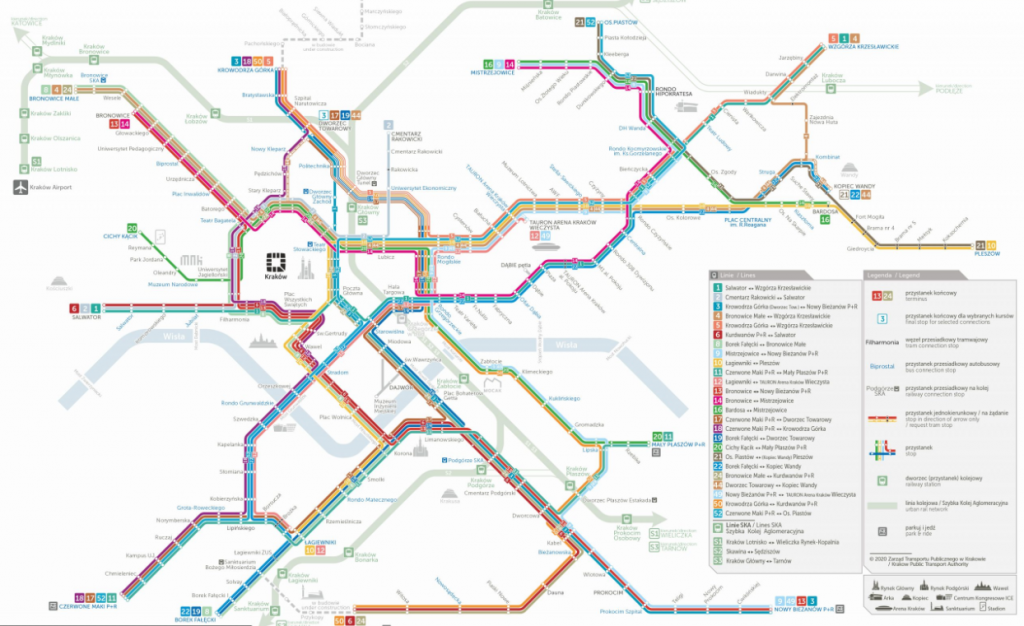
Even though Krakow isn’t served by a metro system, Krakow has a pretty extensive network of trams, made up of almost 30 lines and 80 stations. Along with being particularly useful for residents, connecting their homes and their places of work/study, the tram also covers the entire historic core of the city, extending to the suburban districts where you can find the Factory of Oskar Schindler and the Krakus Mound.
The tram working times depend on the line and the day of the week, though it usually starts running at around 04h30 and finishes off at 23h00.
As for tickets, prices will be different according to the length of the journey. For example, a 20-minute ticket costs 4 PLN, while a 60-minute trip will set you back 6 PLN. You can buy them from the automatic machines located in every single tram stop, or directly though the MPK app, the entity responsible for managing Krakow’s public transportation system. All tickets must be validated inside the vehicles.
That being said, if you plan on using the metro frequently, it’s worth looking into the daily and multi-day options available:
- 24-hour Pass: 17 PLN (or 22 PLN if you wish to travel outside the city center)
- 48-hour Pass: 35 PLN
- 72-hour Pass: 50 PLN
- 7-day Pass: 56 PLN (or 68 PLN if you wish to travel outside the city center)
It’s important to note that once you scan your ticket, it remains valid for a non-stop period of 24, 48 or 72 hours, depending on your choice. So, if you validate a 24-hour ticket at 14h00 on a Saturday, it will be valid until 13h59 of the following day (Sunday).
Krakow City Pass
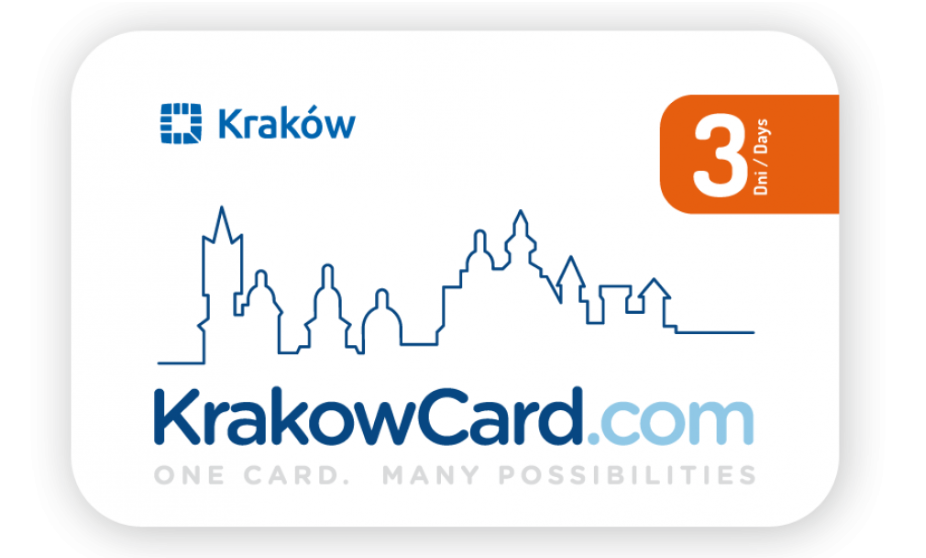
Alternatively, you can consider getting the Krakow City Pass. Available in three versions – 1, 2 or 3 days, this card grants unlimited access to public transportation, plus “free” admission in the city’s most popular tourist attractions for the chosen duration. You can find the full list of partners and benefits on their website.
As for prices, there are the current rates:
- 1 day: €29,55
- 2 days: €45,45
- 3 days: €50,00
In case you expect to visit most of the included attractions but don’t really need to use public transport, there’s also an alternative card that only includes admission to the city’s main landmarks. This pass costs 30,00€ and is valid for 3 days.
Krakow 3-day Travel Guide – Free walking tours

While in Krakow, you have the option to explore the city with a free walking tour. These tours, led by local guides or tour companies, offer guided visits to the historic center, sharing intriguing stories about each place and providing valuable cultural context. Even though these tours are technically free, it’s customary to show appreciation for the guide’s efforts by leaving a tip at the end. In Krakow, a reasonable minimum tip would be around 25 PLN.
That being said, here are a few companies that run free walking tours in Krakow:
Krakow 3-day Travel Guide – Hidden Treasures

With 3 days in Krakow, and although there is definitely plenty to see, you will have enough time to at least cover the main highlights, take a detour to the Wieliczka Salt Mines and visit Auschwitz on a day trip.
Be that as it may, and because we believe a good traveler must always be able to explore beyond the obvious, we wanted to add a few more obscure places to your list of things to see and do in Krakow in 3 days:
Eagle Pharmacy – Once the only pharmacy located inside the former Jewish ghetto, established by Nazi authorities in Krakow. Just like Schindler, the pharmacy’s owner – Tadeusz Pankiewicz, a Polish citizen – was also responsible for saving countless Jewish lives, by providing medication for free and discreetly smuggling food and supplies.
Collegium Maius – The is the most ancient building within the Jagiellonian University, itself one of the world’s oldest academic institutions. Here, you can visit the university museum and see the classrooms, tools and materials used by some of the university’s most renowned students, like Nicolaus Copernicus.
Krakus Mound – This man-made hill is said to be the resting place of the city’s founder, a mythical and legendary figure… well, literally, as there are no documented records of him ever existing. Nevertheless, it’s a great place to enjoy panoramic views of Krakow.
Plaszow Concentration Camp – Located right behind Krakus Mound, little remains of this infamous concentration camp, whose reality was portrayed in “Schindler’s List”. Apart from a handful of crumbling structures and informative plaques, the rest is just a silent, empty space. It takes a toll, but it’s worth the detour if you can’t make it to Auschwitz.
Nowa Huta – This suburban district of Krakow boasts the distinction of being one of the largest examples of Soviet-style brutalist architecture ever conceived. It was designed as the “ideal city” according to communist ideals, featuring the style’s staple wide avenues, uniform buildings and monochromatic colors.
Krakow 3-Day Travel Guide – What to See and Do in 72 Hours
Despite its classical beauty and cultural richness, it is perfectly possible to visit the best of Krakow in 3 days. Besides, with a full 72 hours, you can visit the quarters of Kazimierz and Podgorze, check out the Wieliczka Salt Mines and go on a day trip to the infamous concentration camp of Auschwitz-Birkenau.
Without further ado, here’s what to see and do in Krakow in 3 days:
Krakow 3-Day Travel Guide – Day 1 – Stare Miasto

For your first day in Krakow, you’ll explore its marvelous historic center in depth! Fun fact: this district is so incredible that it was actually part of the very first list of UNESCO World Heritage Sites, a compilation of only 12 places announced way back in 1978! Interestingly, it’s not the only site in the city to have that honor (but more on that later). That being said, your first stop will be at Barbican (16 PLN), located just outside the main gate of the Old Town. In the past, it was internally connected to the city wall, serving as the primary watchtower and acting as a sort of second line of defense. Passing through the gate, you will then stroll along Florianska Street, the most iconic thoroughfare in the Old Town. Centuries ago, this street marked the beginning of the Royal Road, a ceremonial path that concluded at the other end of the historic center (at the castle), and the route for royal processions, grand celebrations and receptions for important foreign dignitaries. As you reach the end of the street, you’ll come face-to-face with the astounding Rynek Glówny, the crowning jewel of the Old Town. Also known as Krakow’s Market Square, this is the largest medieval square in the world, offering an abundance of sights and attractions. In the heart of the square stands the Sukiennice (aka Cloth Hall), the market building where fabrics and spices from all corners of the world were once traded, while the magnificent Saint Mary’s Basilica (free entry to the prayer area; a ticket of 15 PLN is required for accessing other areas) peeks from one corner. Every hour on the clock, you can hear the Hejnal Mariacki playing from one of the basilica’s towers, a trumpet solo that served as a medieval alarm to warn of impending attacks or invasions. While still in the square, I highly recommend ascending the Town Hall Tower (18 PLN, free on Mondays) for some of the best views in Krakow.

After exploring Rynek Glówny, you’ll walk through one of the charming narrow streets of the Old Town and discover Collegium Maius (17 PLN), the most ancient building within the Jagiellonian University, itself one of the world’s oldest academic institutions. Here, you can visit the university museum and see the classrooms, tools and materials used by some of the university’s most renowned students, like Nicolaus Copernicus. By now, you surely will have noticed the absurd number of churches in Krakow, a testament to Poland’s deep Catholic tradition. While there are countless churches to visit in the city center, I’d recommend a visit to Saints Peter and Paul Church, distinguished for the stone statues guarding its entrance. Lastly, to wrap up your tour of the Old Town, you’ll make your way up to the Wawel Royal Castle (35 PLN for the standard tour of the State Rooms, free on Mondays until 13h30). Regarded as one of the most important sites in all of Poland, and the place from where the nation was ruled in ancient times, the complex also houses the stunning Wawel Cathedral (22 PLN), where the country’s kings were crowned. Around the castle, it’s also worth taking a walk along the banks of the Vistula River, a favorite weekend spot among the locals.

First day wrap-up:
- Barbican
- Florianska Street
- Rynek Glówny – Krakow’s Market Square
- Sukiennice – Cloth Hall
- Saint Mary’s Basilica
- Town Hall Tower
- Collegium Maius
- Saints Peter and Paul Church
- Wawel Royal Castle
- Wawel Cathedral
Cheap restaurants in the Old Town:
- Kuchnia U Babci Maliny (Polish traditional)
- Chimera (Polish traditional)
- Pod Wawelem Kompania Kuflowa (Polish traditional)
- Pijalnia wódki i piwa (traditional Polish bar for vodka and beer)
- Wodka Bar (traditional Polish bar for vodka)
- Milkbar Tomasza (bar mleczny – polish cafeteria)
- Smaki Gruzji (Georgian)
- Dolabella Due (Italian)
- Camelot Cafe (coffee and breakfast)
- Chimney Cake Bakery (chimney cake)
Krakow 3-Day Travel Guide – Day 2 – Kazimierz and Podgorze
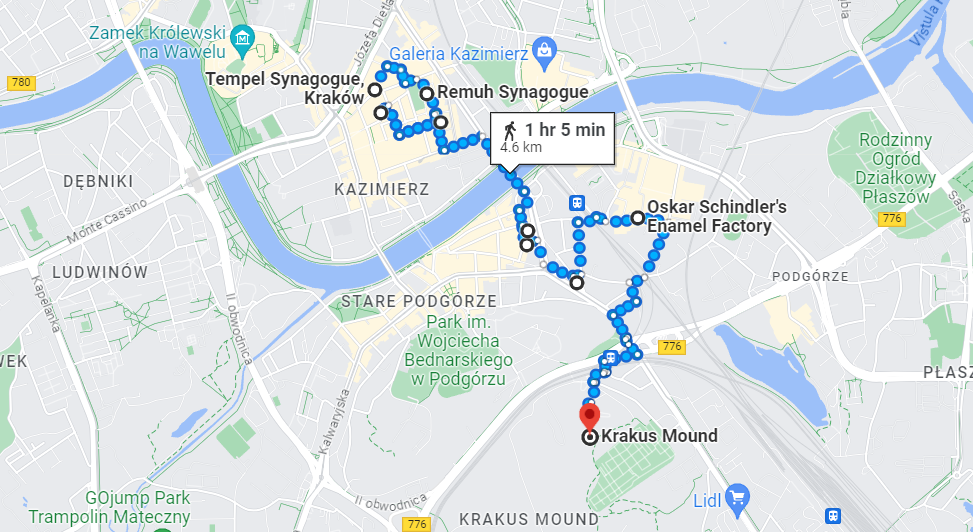
On your second day, as you bid farewell to the Old Town, it’s time to venture into the neighboring district of Kazimierz, still part of the historic center. Historically, Kazimierz stood as an independent town separate from Krakow, famous for the peaceful coexistence between Poles and a once-thriving Jewish community, which was at one time the largest in all of Europe. While there are barely any Jews left in Kazimierz today, owing to the Nazi invasion of Poland and the ensuing persecution, the community’s historical legacy survived, with several synagogues still standing in this quarter. Of the remaining places of worship, you can visit the Old Synagogue (18 PLN, free on Mondays), now transformed into a museum showcasing the city’s Jewish history; the tiny Remuh Synagogue (10 PLN), home to an ancient Jewish cemetery; and the Tempel Synagogue (10 PLN), the largest active cult place in Krakow, serving the district’s small Jewish population. To round off your morning, make sure to swing by Plac Nowy, a vibrant hub of bohemian culture and the perfect spot to savor Zapiekanka, Poland’s most beloved fast-food!
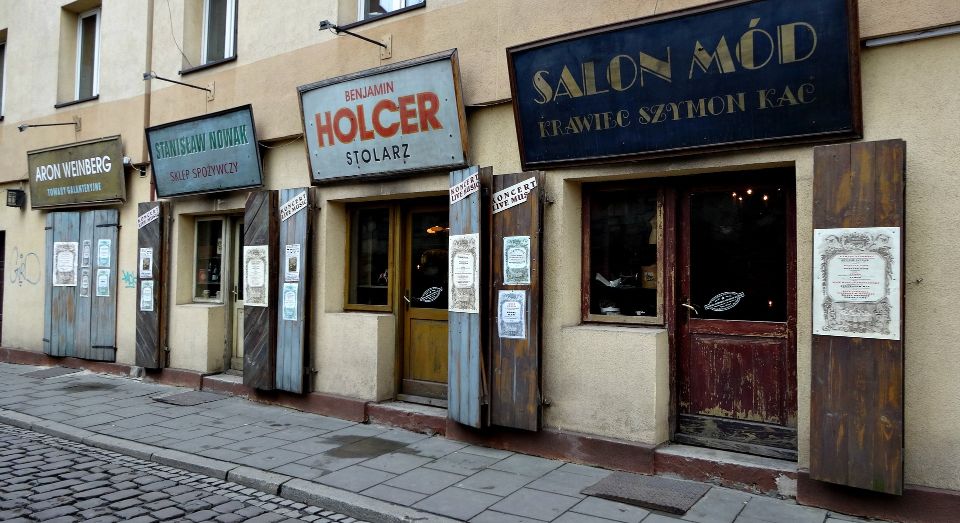
After your snack, the remainder of your day will be spent exploring the district of Podgorze, located just south of Kazimierz, across the Vistula River. After all, this was the area of the city where Nazi authorities established the inhumane Krakow Ghetto, having relocated all the Jews from Kazimierz to this densely populated and inhospitable space. At the heart of Podgorze lies the Ghetto Heroes Square, regarded as the central square of the district. During the ghetto’s tragic liquidation, when houses were emptied and inhabitants were forcibly sent to concentration camps, all possessions and furniture were indiscriminately dumped in this square for plunder. As a memorial, the site now features a monument comprised of 70 metal chairs, symbolizing the emptiness left in the wake of this war crime. Inside one of the buildings surrounding the square, you can also pay a visit to the Eagle Pharmacy (18 PLN, free on Wednesdays), the only pharmacy located inside the former Jewish ghetto. Just like Schindler, the pharmacy’s owner – Tadeusz Pankiewicz, a Polish citizen – was also responsible for saving countless Jewish lives, by providing medication for free and discreetly smuggling food and supplies. Today, the pharmacy is open to visitors, housing a small museum. Although the ghetto was entirely razed at the end of the war, it’s still possible to find a fragment of wall that once marked its boundaries. You can see the Remains of the Ghetto Wall on Lwowska Street.
From there, you’ll dive even deeper into the horrific history of World War II, but now with a famous episode that helps restore some faith in humanity. Made famous by Spielberg’s iconic movie “Schindler’s List”, the renowned Oskar Schindler’s Enamel Factory (32 PLN, free on Mondays) was located in Krakow, specifically in Podgorze. For those unfamiliar with the story, Schindler was a German industrialist who, following the Nazi invasion of Poland, established an enamelware factory in Krakow. The factory produced various items, including cookware and kitchen utensils, which were sold to the German Ministry of Defense. Because his business was deemed crucial to the “war effort”, all of his Jewish employees were spared from being sent to concentration camps. Horrified by the atrocities he witnessed from his fellow countrymen, Schindler made tremendous sacrifices to employ as many Jews as possible, ultimately saving the lives of 1200 people. Today, you can explore the factory and its museum, which tells the story of this former German industrial magnate and exploits the entire Nazi occupation of Krakow between 1939 and 1945. Finally, to lift up your mood at the end of such a somber day (brace yourself, as tomorrow will be even heavier), you can climb to the top of Krakus Mound, an artificial hill said to be the resting place of the city’s founder. Though there are no documented records of this legendary figure ever existing, it is nevertheless a great place to enjoy panoramic views of Krakow.
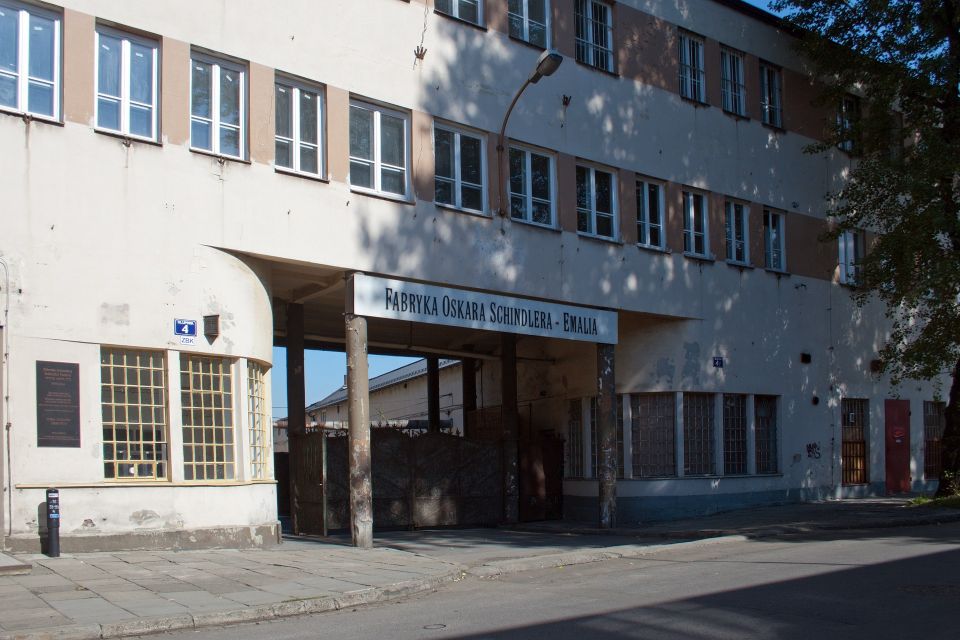
Second day wrap-up:
- Kazimierz
- Old Synagogue
- Remuh Synagogue
- Tempel Synagogue
- Plac Nowy
- Podgorze
- Ghetto Heroes Square
- Eagle Pharmacy
- Remains of the Ghetto Wall
- Oskar Schindler’s Enamel Factory
- Krakus Mound
Cheap restaurants in Kazimierz and Podgorze:
- Goose Restaurant (Polish traditional)
- Kuchnia u Doroty (Polish traditional)
- Krakus (bar mleczny – Polish cafeteria)
- Pierogi MR Vincent (pierogi – Polish traditional)
- Kiełbaski z Niebieskiej Nyski (local Polish sausages)
- Bar pod Okrąglakiem (zapiekanka)
- Gruba Buła (hamburgers)
- ORZO Kraków (varied)
- Mezzalians (Middle Eastern)
- Pan KimBap (Korean)
- Nolio (Italian)
- Tbilisuri (Georgian)
- Akita Ramen (ramen / Japanese)
Krakow 3-Day Travel Guide – Day 3 | Option 1: Auschwitz Birkenau

For your final day in Krakow, we bring you one of the darkest chapters in human history. We all know about the persecution and genocide that the Jews endured during World War II, perhaps the most meticulously organized system of extermination and death ever orchestrated. It was such a ruthless and evil plan, it has forever been recorded in history as the “Holocaust“, a term that can technically be applied to any genocidal operation but will forever be associated with this specific crime. As a pivotal element of the so-called “Final Solution“, the infamous concentration camps were established, where Jews were transported and then selected for forced labor. Those not fortunate enough to be chosen for work, were then sent to the gas chambers, where they were exterminated using Zyklon B. Of all the known camps, none is as famous or horrifying as Auschwitz-Birkenau, whose iconic gate bears the inscription “Arbeit macht frei” (“Work sets you free”) and marks the entry point from which over one million people never returned.
To get to Auschwitz (whose official Polish name is Oświęcim), you’ll need to take a bus. Given this is an extremely popular day trip for those visiting Krakow, there are several local bus companies operating the 90-minute route, all departing from the Central Bus Station. To play it safe and guarantee a seat, you can buy your bus tickets online on Lajkonik Bus (38 PLN for a round trip).

As for your visit, while it’s technically free to enter and explore the camp independently, I strongly recommend paying for a guided tour, as you’ll get a much more complete and emotionally charged experience. You can (and should) book your guided tour in advance on the memorial’s official website. These tours typically last 3h30 hours and cost 90 PLN, while you can purchase an audio guide at the on-site shop (prices vary) for a budget-friendlier alternative. Keep in mind that even if you don’t want to partake in a tour and just wish to roam the site for free, you must still book a designated entry time slot. In this case, select the “Tour for individuals without an educator” option when booking your spot.
Third day wrap-up:
- Auschwitz-Birkenau
Krakow 3-Day Travel Guide – Day 3 | Option 2: Wieliczka Salt Mines
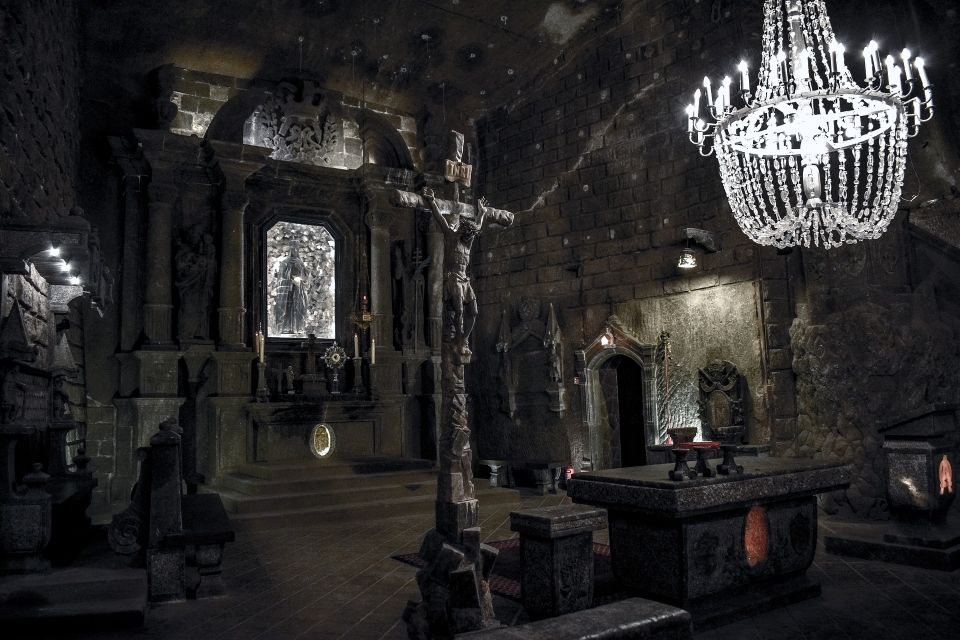
Remember when I mentioned earlier that, besides the historic center, there’s another place in Krakow that’s part of the original list of only 12 UNESCO World Heritage Sites? Well, if you’ve already visited Auschwitz or prefer a less emotionally intense experience, it’s time to introduce you to that other place: the Wieliczka Salt Mines (116 PLN)! Located in the suburbs, less than 15km away from the city center, this site is a true underground palace, where miners carved cathedrals, halls and statues directly into the salt walls. To get to Wieliczka, you can take the suburban train from the Central Railway Station (the same one that comes from the airport), with the journey taking just over 20 minutes. These trains run every 30 minutes, and the ticket price is 6 PLN. Alternatively, you can also take bus 304, which departs from a stop located near the main bus station (right here). The vehicle’s destination is marked as “Wieliczka Os. Asnyka”, but you should get off two stops earlier at “Wieliczka Kopalnia Soli”. The ticket price is exactly the same, and the journey takes 40 minutes, with a new bus passing by every 10/20 minutes.
As for the underground visit, it’s conducted in groups and includes the presence of a guide who will provide details about the highlights of the tour and the daily lives of the miners who used to work here. To ensure you can explore the mines at a time that suits you, I highly recommend purchasing tickets online well in advance.
Third day wrap-up:
- Wieliczka Salt Mines
Got more than 3 days in Krakow? Then you might want to check out the best day trips from the city:
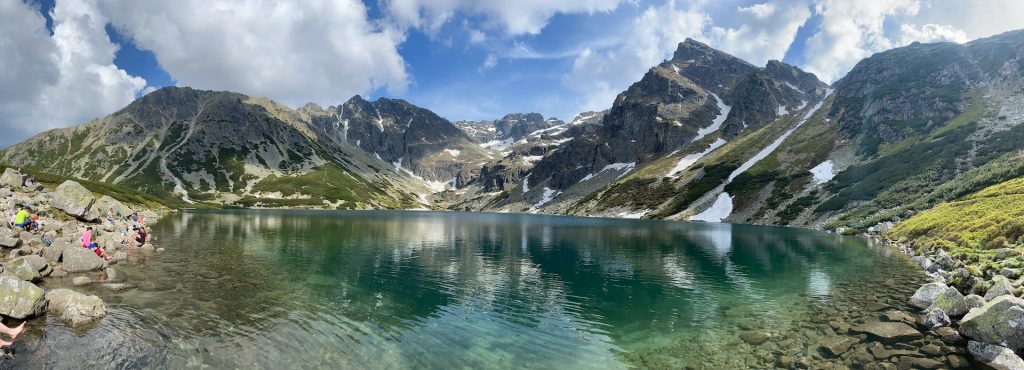
- Tarnów – Located about an hour away from the big city, Tarnów can be described as a mini-Krakow of sorts, filled with historic buildings, a lovely central square and several remnants of its once vibrant Jewish community.
- Zalipi – Just a stone’s throw from Tarnów, this village has captured the attention of travelers thanks to the decorative paintings and artwork that adorn the façade of nearly every house. A lovely place!
- Zakopane – Ideally, it’s best to spend a night in Zakopane. However, even with just a single day at your disposal, it’s well worth the visit, especially to experience the hike to Morskie Oko, the largest lake in the Tatra Mountains.
- Ojców National Park – Beyond the opportunity to explore this expansive natural park, you can also take on the hike to Pieskowa Skala, arguably the most popular of the 20 castles located along the Trail of the Eagle’s Nests.
- Wroclaw – While it will definitely not be enough to experience all the city has to offer, it’s still very much worth visiting Wroclaw even if all you have in one day. With its vibrant student community and a beautiful historic center, Wroclaw ranks among my favorite Polish cities.
Traveling soon? Get your Holafly eSIM with a 5% discount for unlimited internet access in any destination. No more worrying about roaming charges or finding local SIM cards. Enjoy unlimited data and stay connected with ease. Order your Holafly eSIM now »
Heymondo offers a wide range of travel assistance insurance policies. They combine the best quality, service and price with various levels of coverage, so you’re covered on your weekend getaways and long trips. Click here to get 5% off on your travel insurance »








